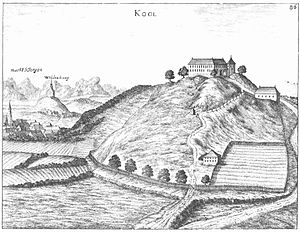Kogl Castle
| Kogl Castle | ||
|---|---|---|
|
Kogl Castle after an engraving by Georg Matthäus Vischer from 1674 in the Topographia Austriae superioris modernae |
||
| Alternative name (s): | Neuattersee | |
| Creation time : | 1264 | |
| Castle type : | Hilltop castle | |
| Conservation status: | Wall remains | |
| Place: | St. Georgen im Attergau | |
| Geographical location | 47 ° 56 '16 " N , 13 ° 27' 46" E | |
| Height: | 680 m above sea level A. | |
|
|
||
The castle Kogl is the ruin rest a hilltop castle on the 680 m high Koglberg in the district Kogl the municipality of St. Georgen im Attergau in District Vöcklabruck of Upper Austria .
history
The Palatinate “Atarhoven” (Atarnchova, Atterhof, Attersee) is mentioned as early as the 8th century as an Agilolfingian possession and from 788 as a Franconian-royal estate in Attergau . The diocese of Bamberg came into the possession of the royal palatinate "Atarhoven" in 1007 due to a donation from King Heinrich II . This was intended to support the construction of Bamberg Cathedral . Kogl Castle was built in 1264 at the instigation of Bishop Berthold von Bamberg in place of Attersee Castle, which was built in 1007 . At first the castle was called Neuattersee, but then the name Kogl became common.
The castle had many changing owners, and it was often given as a pledge. Owners were from 1249 to 1309 Chunrad der Zizmann, Heinrich der Zizmann and Haidfoch. The Bamberg bishop pledged the castle to the Schaunbergers in 1309–1342 , and it then came to Chunrad Kuchler and Hertel's son. In 1379 Kogl came to Duke Albrecht III as a Bamberg fief. from Austria. The Habsburgs later “overlooked” the fact that they only had the castle as a fiefdom and for their part gave Kogl as a sovereign fiefdom or pledged the property. The first pledgee was Count Herrmann von Cilli. He was followed by Heinrich von Wallsee (1411), until 1416 Hans Eitzinger was a pledge holder. In 1453 King Ladislaus ordered the caretaker Michael Albrechtsheimer to hand over Kogl to Gilg Vischmeister. Kogl then took over Reinprecht V. von Walsee from Ortolph Geymann . After the Wallseer died out (1483), Emperor Friedrich III. Kogl as a fallen fiefdom itself. His successor, Emperor Maximilian I , pledged the rule of Kogl to his governor Wolfgang von Polheim (1499). As the Pollheimers were Protestants, the property was given to Hans Hofmann by King Ferdinand I. In 1550 King Ferdinand allowed his chamberlain Johann Hofmann von Grünpichl to redeem Kogl from the pledge of Cyriak von Pohlheim. Emperor Rudolf II finally paid off the pledge in 1570. Kogl became its own regional court in 1581. Finally, Emperor Rudolf II decided in 1581 to sell Kogl as well as Schloss Kammer and Schloss Frankenburg to his ambassador in Madrid, Hans Freiherr von Khevenhüller . His successor was his Protestant brother Bartholomäus, who was followed by his Catholic son Franz Christoph. In 1594 Kogl Castle was considered a defensible refuge in times of war. In 1619 Kogl is leased to Abraham Grünpacher. In 1620 Kogl is taken by the Protestant Hans Geymann (Geumann); this also chased the pastor from Lochen, plundered the rectory and had the booty brought to Kogl. During the religious disputes, the Protestant Karl von Jörger occupied the castle. Geymann was used as a nurse, but had to flee from the onrushing Bavarian troops.
At the beginning of the second half of the 18th century, the Khevenhüller decided to leave the building, which was no longer up-to-date and difficult to reach in terms of traffic. In 1750 they built the new Kogl Castle at the foot of the Koglberg . Since the castle was no longer permanently inhabited, it began to decline.
Kogl castle ruins today
Only a few wall sections are left of the castle. The Burgplatz is still surrounded by a moat , but it is so overgrown that it is hardly recognizable. The ruin is not a listed building.
literature
- Norbert Grabherr : Castles and palaces in Upper Austria. A guide for castle hikers and friends of home . 3. Edition. Oberösterreichischer Landesverlag, Linz 1976, ISBN 3-85214-157-5 .
- Oskar Hille: Castles and palaces in Upper Austria then and now . Verlag Ferdinand Berger & Sons, Horn 1975, ISBN 3-85028-023-3 .
- Christian K. Steingruber : A critical consideration of the historical-topographical manual by Norbert Grabherr . Upper Austrian Provincial Archives , Linz 2013.

